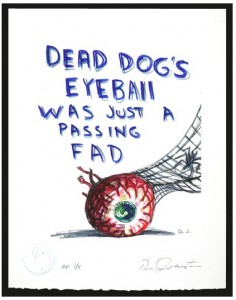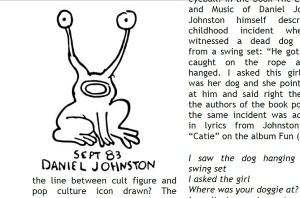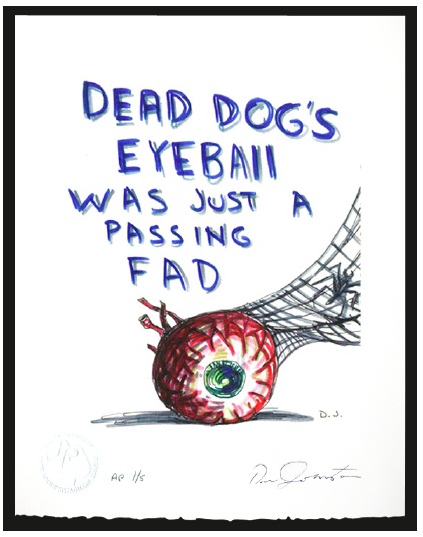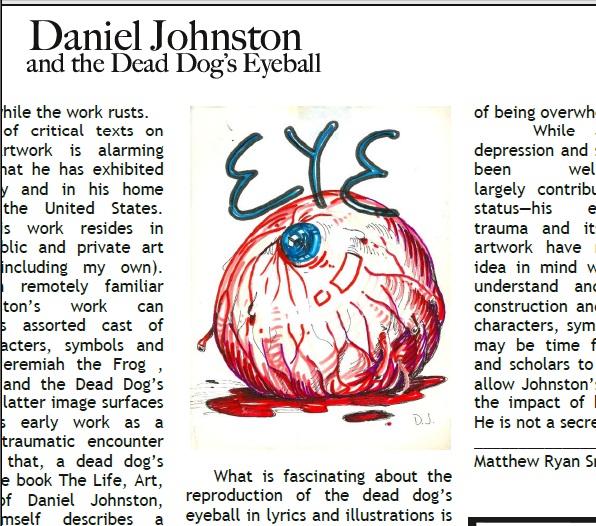 Daniel Johnston is not a secret anymore. Thirteen years ago, in 2005, director Jeff Feuerzeig released the Sundance award-winning documentary on Johnston’s life “The Devil and Daniel Johnston,” his songs have been covered by renowned artists like Beck, Tom Waits and The Flaming Lips and he has also been featured in the 2006 Whitney Biennial of American Art. It seems that over the past few years the enigma that was Johnston has mutated into a proverbial “cult figure.” However this cliché is an inaccurate description. Where is the line between cult figure and pop culture icon drawn? The common theme found in essays and reviews on Johnston’s work is the examination of his mythology rather than the examination of his work. This type of analysis tends to do more harm than good: the myth swells while the work rusts.
Daniel Johnston is not a secret anymore. Thirteen years ago, in 2005, director Jeff Feuerzeig released the Sundance award-winning documentary on Johnston’s life “The Devil and Daniel Johnston,” his songs have been covered by renowned artists like Beck, Tom Waits and The Flaming Lips and he has also been featured in the 2006 Whitney Biennial of American Art. It seems that over the past few years the enigma that was Johnston has mutated into a proverbial “cult figure.” However this cliché is an inaccurate description. Where is the line between cult figure and pop culture icon drawn? The common theme found in essays and reviews on Johnston’s work is the examination of his mythology rather than the examination of his work. This type of analysis tends to do more harm than good: the myth swells while the work rusts.
The lack of critical texts on Johnston’s artwork is alarming considering that he has exhibited internationally and in his home country of the United States. Moreover, his work resides in numerous public and private art collections (including my own). Anyone even remotely familiar with Johnston’s work can recognize his assorted cast of unusual characters, symbols and motifs like Jeremiah the Frog (refer to images above and below), Vile Corrupt and the Dead Dog’s Eyeball. The latter image surfaces in Johnston’s early work as a result of a traumatic encounter with exactly that, a dead dog’s eyeball. In the book The Life, Art, and Music of Daniel Johnston, Johnston himself describes a childhood incident where he witnessed a dead dog hanging from a swing set: “He got himself caught on the rope and got hanged. I asked this girl where was her dog and she pointed over at him and said right there.” As the authors of the book point out, the same incident was addressed in lyrics from Johnston’s song “Catie” on the album Fun (1994):
I saw the dog hanging on the swing set
I asked the girl
Where was your doggie at?
I walked on down to see my grandpa yeah!
Well I’ve had a lot of horrors
And I’ve had a lot of fears
But the worst of horror
Is when there’s nothing here
 What is fascinating about the reproduction of the dead dog’s eyeball in lyrics and illustrations is that it may be connected to the trauma Johnston experienced when first encountering the dead dog on the swing set. Trauma is characterized by an affective shock that has the capacity to wound the body and the psyche, which in turn causes anxiety, stress and other forms of neurosis. Seeing the dead dog’s eyeball during childhood might have registered trauma in Johnston that affects him well into his adult life and it could have taken the form of an obsession (fig. 4). In one particular drawing from his early work Johnston asks himself in bold text, “WHY DO I KEEP DRAWINGS [sic] THESE SILLY LITTLE EYEBALLS?” Here and elsewhere, the artist is consumed by flashbacks of the dead dog’s eyeball to the extent of being overwhelmed.
What is fascinating about the reproduction of the dead dog’s eyeball in lyrics and illustrations is that it may be connected to the trauma Johnston experienced when first encountering the dead dog on the swing set. Trauma is characterized by an affective shock that has the capacity to wound the body and the psyche, which in turn causes anxiety, stress and other forms of neurosis. Seeing the dead dog’s eyeball during childhood might have registered trauma in Johnston that affects him well into his adult life and it could have taken the form of an obsession (fig. 4). In one particular drawing from his early work Johnston asks himself in bold text, “WHY DO I KEEP DRAWINGS [sic] THESE SILLY LITTLE EYEBALLS?” Here and elsewhere, the artist is consumed by flashbacks of the dead dog’s eyeball to the extent of being overwhelmed.
While Johnston’s manic depression and schizophrenia have been well-documented—and largely contribute to his mythic status—his encounters with trauma and its relation to his artwork have not. Keeping this idea in mind will help to better understand and appreciate the construction and trajectory of his characters, symbols and motifs. It may be time for writers, critics and scholars to take a step back, allow Johnston’s myth to rust and the impact of his work to swell. He is not a secret anymore. For the Silo, Matthew Ryan Smith, P.H.D.
Tarssa Yazdani and Don Goede, The Life, Art, and Music of Daniel Johnston (San Francisco and Colorado Springs: Smokemuse and Last Gasp, 2006). 33-34.


